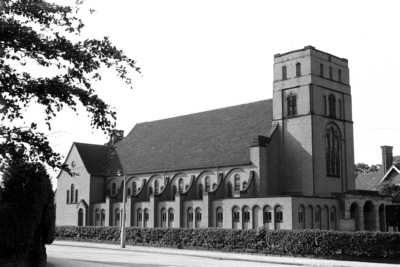 |
 |
|
The Early Years,
building a "School Chapel"
|
|
| It was on May 31st
1897 that a committee first met to build a new church in Hale. They issued
a brochure which stated - "The rapid growth of the residential district lying between the Hale Road and the Ashley Road, Altrincham, and the great increase of the population during the last few years have obliged the officers and other members and friends of the Bowdon Downs Congregational Church to consider the question of providing for formation of a New Church there. ...An eligible plot of ground has been secured on the right-hand side of Ashley Road, near to Park Road. It is proposed to erect at once a School-Church; leaving ample space in front for the main building which is to follow." Messrs. W. Lambert & Son were employed for "the erection of a School-Church, consisting of a Large Hall, with four classrooms, which be easily made part of the auditorium when it is needed, and an Infants' room which may also be used as a Church Parlour." The total cost was £3,700, of which £780 was for purchase of the Chief Rent of the land to avoid an annual financial burden. The committee ensured that the brochure included the names of donors and amounts of money already given, no doubt to encourage support.
|
|
|
Pepper Street Chapel.
|
|
|
The church records show that at this time the minister at Hale had oversight of "Pepper Street Chapel" in Mobberley. We know little about this - apart from the fact that the minister would sometimes take services there in the afternoon after morning service at Hale. What transport he used is not known, but it is a fair walk between the chapels. In WW1 the members of Pepper Street who served in the military were recorded along with those from Hale, and appear on our memorial. The chapel is described in here
as "Knolls Green, United Reformed Church (Independent/Congregational),
Pepper Street. Built in 1783 as a Methodist Chapel (Wesleyan), taken
over by Independents in 1803, closed in 1961. Mobberley- Knolls (also
spelt Knowles) Green" The dates are confusing, claiming it was
closed before the Union in 1972. However, Ringheye Morris dancers
practised there after their formation in 1983 "until the chapel
hall closed". (The nearby Chapel House Inn was very convenient
after dancing.) |
|
|
Time of Expansion, building the
New Schools
|
|
|
In 1880 education became compulsory for all children aged 5-10. When the Hale School Chapel opened the age range had been extended to 12, and was eventually extended to 14 in 1918. At the time, church schools provided about half the available schooling. In 1902 the Balfour Act was passed by parliament
putting education under local education authorities, it allowed for
the funding of sectarian schools, notably Anglican and Catholic. Non-conformists
opposed the change, arguing that (1) the rate aid was being used to
support the teaching of religious views to which some rate-payers were
opposed; (2) sectarian schools, supported by public funds, were not
under public control; (3) teachers in sectarian schools were subject
to religious tests. However, the legislation passed, but It cost the
government the election. |
|
|
Completion of the New Church
|
|
| There seemed to be a
surplus of cash left over from building the schools and the extensions
committee moved onto constructing the new church which opened in October
1913. The local paper reported that of the cost £5500, £200
remained outstanding, but this was liquidated during the opening ceremonies.
The old chapel was demoted to the status of lecture hall. There were adjustments to be made. An American organ was installed in the chapel during building, whilst the pipe organ was moved to the new church and upgraded from a two to a three manual. It was provided with an electric pump which proved to be unnecessarily noisy. The man who had been paid to pump the organ was now paid to run the cloak-room on Sundays. The ladies busied themselves with putting a carpet around the new communion table; it took four months to decide the colour. It was grey. |
 |
|
And then came World War One... NEXT PAGE |
|
|
SITE MAP for Altrincham
United Reformed Church HISTORY PAGES
|
|
|
CLICK
THE TITLES BELOW TO CONTINUE TO EXPLORE THIS ARCHIVE.
|
|
|
Historical Archives
|
|
|
Members Contributions to Exhibitions
and Presentations.
|
|
|
WWII-
Christmas 1940 - the blitz on Altrincham. |
|
|
|
|